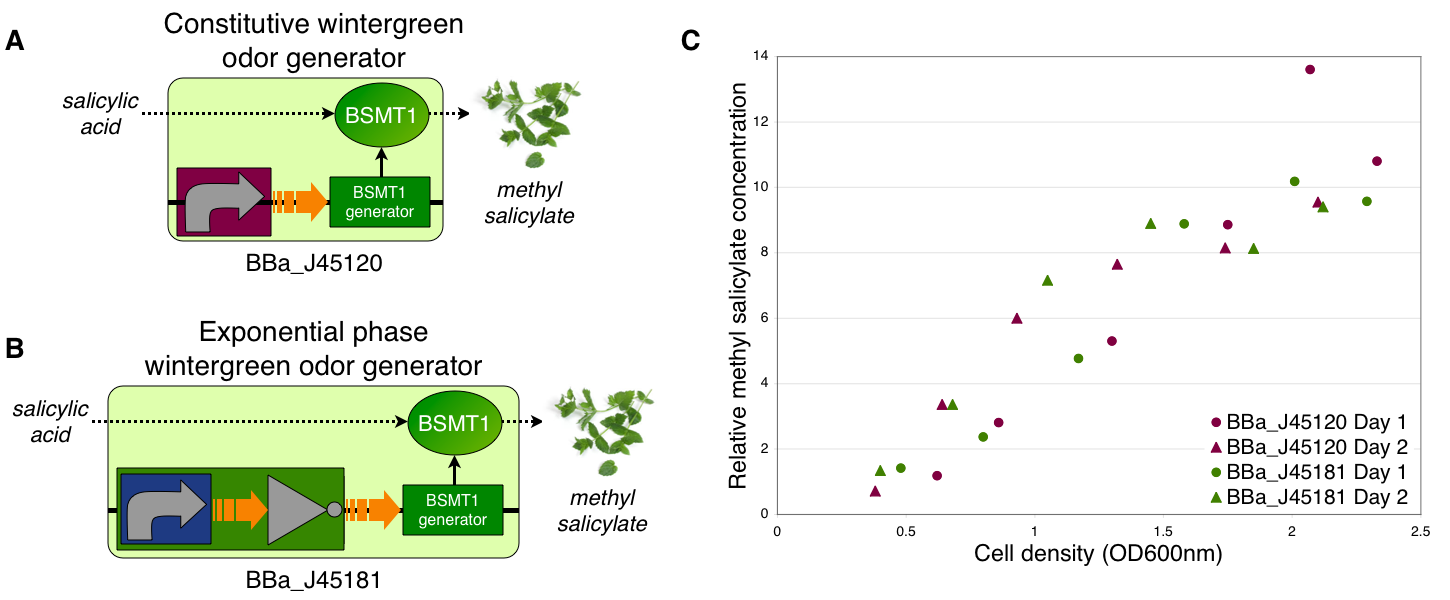Generator
BSMT1
Part:BBa_J45119:Experience
Designed by: Boyuan Zhu Group: iGEM06_MIT (2006-08-10)
Revision as of 02:25, 8 March 2008 by Rshetty (Talk | contribs) (→Use of BSMT1 generator in wintergreen odor generator)
This experience page is provided so that any user may enter their experience using this part.
Please enter
how you used this part and how it worked out.
Applications of BBa_J45119
Wintergreen odor based reporter of transcriptional signal.
User Reviews
UNIQe58bc88e74cc0679-partinfo-00000000-QINU
|
••••• |
BBa_J45119 was successfully used to produce wintergreen odor under the control of BBa_R0040 in the wintergreen odor generator BBa_J45120. |
UNIQe58bc88e74cc0679-partinfo-00000005-QINU
Characterization
Use of BSMT1 generator in wintergreen odor generator
The BSMT1 enzyme generator (BBa_J45119) is used in both wintergreen odor generators (BBa_J45120 and BBa_J45181).

Growth phase dependent wintergreen odor production
To demonstrate growth phase dependent wintergreen odor production, we compared the behavior of constitutive and exponential phase dependent wintergreen odor generators (A and B, respectively). We measured methyl salicylate concentration (relative to the pentachloronitrobenzene internal standard) of cultures of the constitutive and exponential phase wintergreen odor generators at different culture cell densities (OD600nm) (C). The constitutive and exponential phase wintergreen odor generators produced similar levels of methyl salicylate at all cell densities examined. Thus, the exponential phase wintergreen odor generator does not work as intended.
To demonstrate growth phase dependent wintergreen odor production, we compared the behavior of constitutive and exponential phase dependent wintergreen odor generators (A and B, respectively). We measured methyl salicylate concentration (relative to the pentachloronitrobenzene internal standard) of cultures of the constitutive and exponential phase wintergreen odor generators at different culture cell densities (OD600nm) (C). The constitutive and exponential phase wintergreen odor generators produced similar levels of methyl salicylate at all cell densities examined. Thus, the exponential phase wintergreen odor generator does not work as intended.
Smell test of wintergreen odor generator
The wintergreen odor generator (BBa_J45120) includes the BSMT1 enzyme generator (BBa_J45119) under the control of a constitutive promoter (BBa_R0040).

Smell tests of cultures of wintergreen and banana odor generators (BBa_J45120 and BBa_J45200, respectively)
At the 2006 iGEM Jamboree, we conducted blind smell tests in which iGEM participants had to distinguish between cell cultures producing wintergreen odor, banana odor and the natural fecal odor of E. coli. Of the 116 respondents, 64% were able to correctly identify the culture producing methyl salicylate through its wintergreen bouquet, 87% were able to correctly identify the culture producing isoamyl acetate through its banana bouquet, and 86% were able to correctly identify the laboratory E. coli strain TOP10 through its stink. The error bars are the specific margin of error at 95% confidence. For the smell tests, we used the odor-free chassis (E. coli strain YYC912) for the wintergreen and banana odor generators.
At the 2006 iGEM Jamboree, we conducted blind smell tests in which iGEM participants had to distinguish between cell cultures producing wintergreen odor, banana odor and the natural fecal odor of E. coli. Of the 116 respondents, 64% were able to correctly identify the culture producing methyl salicylate through its wintergreen bouquet, 87% were able to correctly identify the culture producing isoamyl acetate through its banana bouquet, and 86% were able to correctly identify the laboratory E. coli strain TOP10 through its stink. The error bars are the specific margin of error at 95% confidence. For the smell tests, we used the odor-free chassis (E. coli strain YYC912) for the wintergreen and banana odor generators.

 1 Registry Star
1 Registry Star